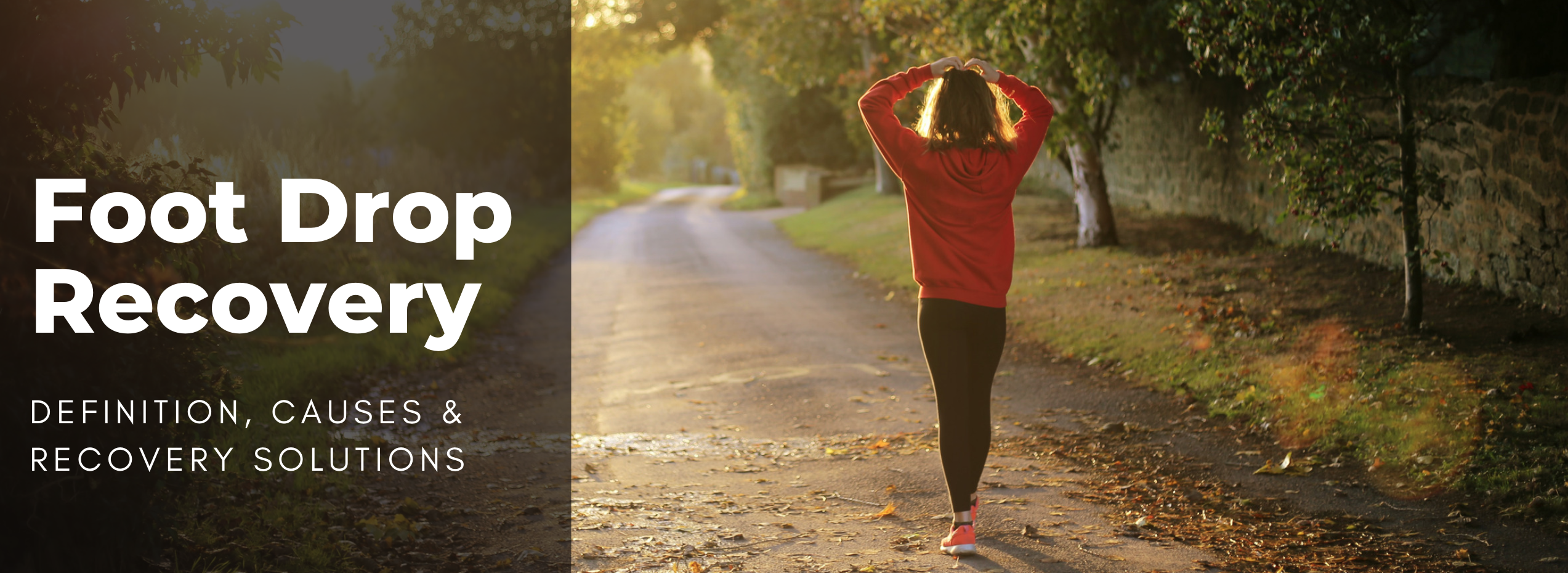
Foot Drop Recovery: Definition, Causes, & Recovery Solutions

Foot drop, also known as drop foot, is the inability to raise the front part of the foot due to weakness or paralysis of the muscles that lift the foot (National Institute of Neurological Disorders). It can be a temporary or permanent situation, so address this as soon as you see any signs. Foot drop is not a disease but a symptom of an underlying muscular, neurological, or anatomical disorder. This blog will educate you on what foot drop is, common reasons that it occurs, and also possible treatment options.
Three Causes of Foot Drop
There are three main causes of foot drop: nerve injury, muscle disorders, and brain and spinal cord disorders. Working with a medical professional will help you determine what is causing foot drop.
Cause #1: Nerve Injury
Firstly, the most common cause of foot drop is damage to or compression of the peroneal nerve. The peroneal nerve is a nerve that carries signals from your brain and lets you contract the muscles that lift the front part of your foot. Damage to the peroneal nerve can come from sports injuries, low back injuries, childbirth, and much more.
Cause #2: Muscle Disorders
Secondly, foot drop can be a result of muscle disorders. Muscle disorders are conditions that cause muscles to slowly weaken or deteriorate over time causing foot drop. These disorders may include muscular dystrophy, Charcot-Marie-Tooth disease, or polio.
Cause #3: Brain or Spinal Corder Disorders
Thirdly, foot drop occurs from brain or spinal cord disorders. These are disorders that affect the brain and spinal cord directly. These conditions may include stroke, cerebral palsy, multiple sclerosis or MS, or amyotrophic lateral sclerosis, better known as ALS or Lou Gehrig's disease.
Treatment Options
There are four popular ways to treat foot drop: surgery, electrical stimulation, AFOs, and rehabilitation.
Treatment #1
The first treatment option for foot drop is surgery. For example, surgery is more likely to be the chosen option for treatment if a pinched nerve or herniated disc is causing the foot drop symptoms. A physician might suggest that the ankle and foot bones be fused to improve a person's gait and ability to walk.
Treatment #2
If surgery is not required, electrical stimulation is a second option for treating the nerves and muscles causing the foot drop. There are two common types of electrical stimulation: FES and NMES. FES, or functional electrical stimulation, is administered in two ways. One by wearing an e-stim device designed for long-distance ambulation, and two, by using an electrical stimulation device with a hand-held trigger.
The device is worn just below the knee and stimulates the normal function of the peroneal nerve. Therefore, the forefoot lifts at a calculated time and helps contract the muscles lifting the front of your foot. There is the option of using an e-stim device, like the SaeboStim Pro, which has an FES trigger for functional training.

The SaeboStim Pro has NMES, or neuromuscular electrical stimulation, which treats foot drop by applying electrical stimulation to the muscles that lift your foot. The e-stim device will cycle on and off, having the muscles contract repeatedly.
The SaeboStim Spa provides extremely safe, low-level electrical stimulation designed to improve sensation, reduce spasticity, improve function, and decrease pain in the foot. The device works by submerging the involved foot, along with the associated rubber electrodes, into the water for a 30-minute stimulation session.

The SaeboStim Spa provides circumferential “underwater” nerve stimulation that is consistent, comfortable, and evenly distributed throughout the affected area. This form of stimulation surrounds the feet with a soothing and uniform level of current that treats the underlying conditions.
Treatment #3
A third way to treat foot drop is using braces or ankle-foot orthoses, better known as AFOs. Wearing an orthotic (AFO) that supports the foot in a normal position is a common treatment for foot drop. The device stabilizes the foot and ankle while holding the front part of your foot off the ground when walking. Traditionally, doctors have prescribed bulky, stiff splints that go inside your shoe, like a plastic or carbon fiber AFO.
There is an alternative like the out-of-the-shoe AFO, the SaeboStep. The SaeboStep is a lightweight, cost-effective, and low-profile foot drop brace. The brace sits around the ankle and not inside the shoe. Users can wear it with almost any type of shoe, concealing it under clothing. The device encourages the muscles of the foot and ankle to work together. This engages the correct muscles leading to a better, more progressive recovery.

Accelerate your recovery by combining the SaeboStim Spa and the SaeboStep. First, use SaeboStim Spa to provide an extremely safe, low-level electrical stimulation. This device is designed to improve sensation, reduce spasticity, improve function, and decrease pain in the foot. It works by submerging the involved foot, along with the associated rubber electrodes, into the water for a 30-minute stimulation session.

Once you are done with your session, put on the fully adjustable SaeboStep. SaeboStep was designed to replace uncomfortable, stiff, or bulky splints that go inside the shoe as well as poorly manufactured braces designed for outside of the shoe that lack support and durability. It was designed to be worn comfortably with the majority of male or female shoe styles. Individuals can use their favorite shoes by ordering the accessory kit to enable footwear without eyelets to be modified.
Treatment #4
Lastly, participating in physical or occupational therapy is the fourth treatment option. Therapy that strengthens the foot, ankle, and lower leg muscles are fundamental for treating drop foot. Stretching and range of motion exercises are great to add to your therapy regimen.
Get Back on Your Feet!
In conclusion, when it comes to foot drop, ask questions, learn what you can, and weigh your treatment options. We hope this blog has helped you learn a little bit about foot drop and that you'll check out the entire lineup of Saebo products that can help with your recovery. For more information on the SaeboStep, the SaeboStim Pro, or any of our other innovative devices, please visit us on our website, any of our social media sites, or go to the Saebo YouTube page where we have tons of videos.
All content provided on this blog is for informational purposes only and is not intended to be a substitute for professional medical advice, diagnosis, or treatment. Always seek the advice of your physician or other qualified health providers with any questions you may have regarding a medical condition. If you think you may have a medical emergency, call your doctor or 911 immediately. Reliance on any information provided by the Saebo website is solely at your own risk.
All content provided on this blog is for informational purposes only and is not intended to be a substitute for professional medical advice, diagnosis, or treatment. Always seek the advice of your physician or other qualified health providers with any questions you may have regarding a medical condition. If you think you may have a medical emergency, call your doctor or 911 immediately. Reliance on any information provided by the Saebo website is solely at your own risk.


